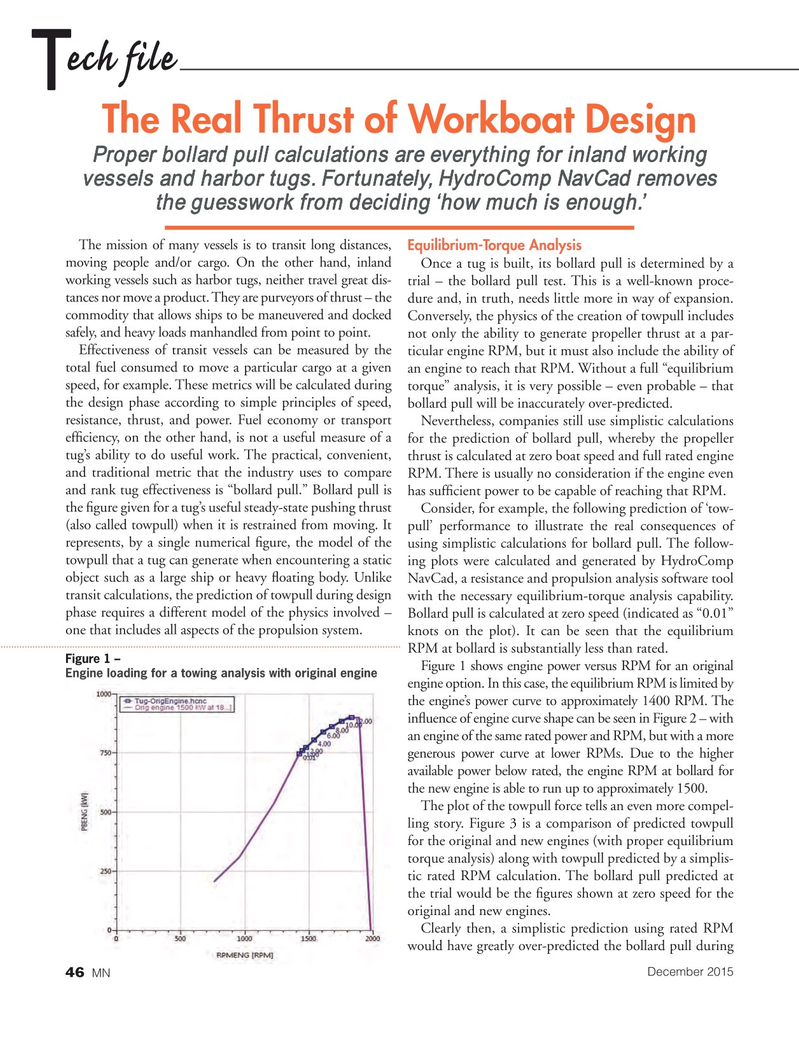
Page 46: of Marine News Magazine (December 2015)
Innovative Products & Boats of 2015
Read this page in Pdf, Flash or Html5 edition of December 2015 Marine News Magazine
ech file
T
The Real Thrust of Workboat Design
Proper bollard pull calculations are everything for inland working vessels and harbor tugs. Fortunately, HydroComp NavCad removes the guesswork from deciding ‘how much is enough.’
The mission of many vessels is to transit long distances, Equilibrium-Torque Analysis moving people and/or cargo. On the other hand, inland Once a tug is built, its bollard pull is determined by a working vessels such as harbor tugs, neither travel great dis- trial – the bollard pull test. This is a well-known proce- tances nor move a product. They are purveyors of thrust – the dure and, in truth, needs little more in way of expansion. commodity that allows ships to be maneuvered and docked Conversely, the physics of the creation of towpull includes safely, and heavy loads manhandled from point to point. not only the ability to generate propeller thrust at a par-
Effectiveness of transit vessels can be measured by the ticular engine RPM, but it must also include the ability of total fuel consumed to move a particular cargo at a given an engine to reach that RPM. Without a full “equilibrium speed, for example. These metrics will be calculated during torque” analysis, it is very possible – even probable – that the design phase according to simple principles of speed, bollard pull will be inaccurately over-predicted.
resistance, thrust, and power. Fuel economy or transport Nevertheless, companies still use simplistic calculations ef? ciency, on the other hand, is not a useful measure of a for the prediction of bollard pull, whereby the propeller tug’s ability to do useful work. The practical, convenient, thrust is calculated at zero boat speed and full rated engine and traditional metric that the industry uses to compare RPM. There is usually no consideration if the engine even and rank tug effectiveness is “bollard pull.” Bollard pull is has suf? cient power to be capable of reaching that RPM.
the ? gure given for a tug’s useful steady-state pushing thrust Consider, for example, the following prediction of ‘tow- (also called towpull) when it is restrained from moving. It pull’ performance to illustrate the real consequences of represents, by a single numerical ? gure, the model of the using simplistic calculations for bollard pull. The follow- towpull that a tug can generate when encountering a static ing plots were calculated and generated by HydroComp object such as a large ship or heavy ? oating body. Unlike NavCad, a resistance and propulsion analysis software tool transit calculations, the prediction of towpull during design with the necessary equilibrium-torque analysis capability. phase requires a different model of the physics involved – Bollard pull is calculated at zero speed (indicated as “0.01” one that includes all aspects of the propulsion system. knots on the plot). It can be seen that the equilibrium
RPM at bollard is substantially less than rated.
Figure 1 –
Figure 1 shows engine power versus RPM for an original
Engine loading for a towing analysis with original engine engine option. In this case, the equilibrium RPM is limited by the engine’s power curve to approximately 1400 RPM. The in? uence of engine curve shape can be seen in Figure 2 – with an engine of the same rated power and RPM, but with a more generous power curve at lower RPMs. Due to the higher available power below rated, the engine RPM at bollard for the new engine is able to run up to approximately 1500.
The plot of the towpull force tells an even more compel- ling story. Figure 3 is a comparison of predicted towpull for the original and new engines (with proper equilibrium torque analysis) along with towpull predicted by a simplis- tic rated RPM calculation. The bollard pull predicted at the trial would be the ? gures shown at zero speed for the original and new engines.
Clearly then, a simplistic prediction using rated RPM would have greatly over-predicted the bollard pull during
December 2015 46 MN
MN Dec15 Layout 32-49.indd 46 11/24/2015 9:37:49 AM

 45
45

 47
47
